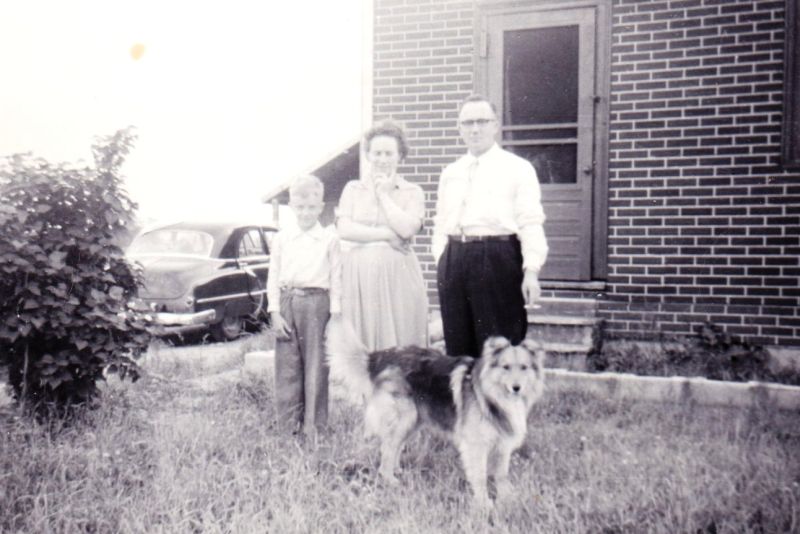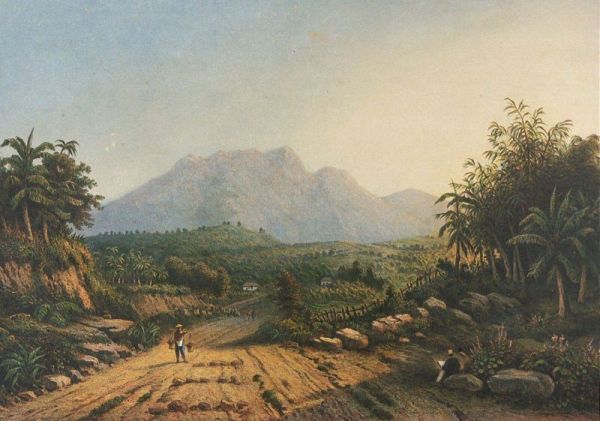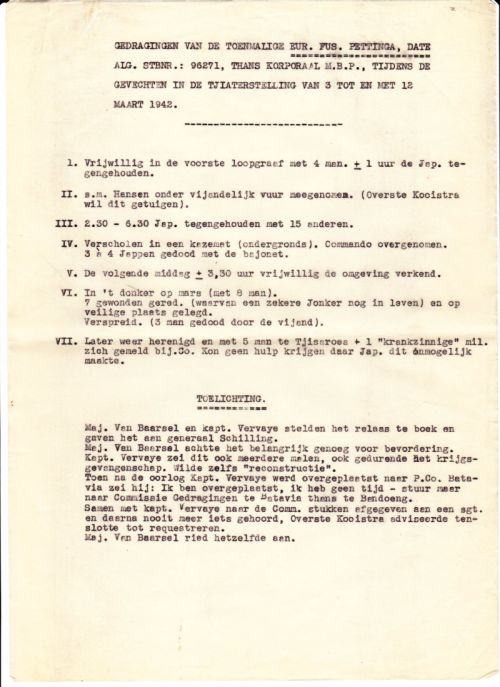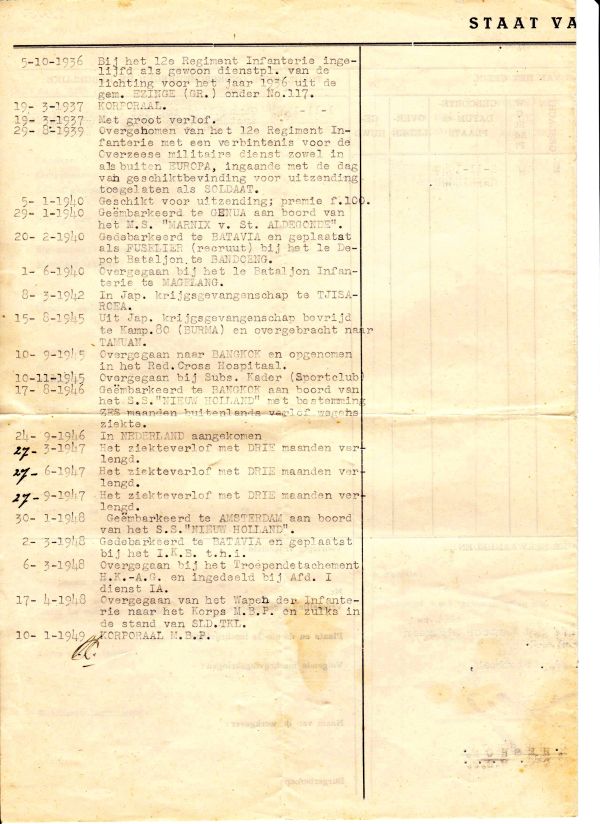On the road to the Tjiater fortifications at Bandoeng
Introduction
What will follow are parts of a diary written by Date Pettinga, born on the 27th of June 1916 in Oldehove. During the Second World War he was stationed in the Dutch-Indies, where he took part in the fight against the Japanese. He joined the 12th Regiment Infantry as a conscript in 1936 and left the army one year later with the rank of corporal. However, in 1939 he returned to the military. He served as a soldier in Bandoeng, West Java, before he was transferred in 1939 to the first Infantry Battalion in Magelang, Central Java.
On the road to the Tjiater fortifications at Bandoeng
January 1942. We were busy constructing the new defense positions at the coast of Rembang. One house after the other was evacuated on the orders of our commander, or moved to the other side of the main road. Due to the threat of a Japanese invasion, the eastern part of the Dutch-Indies had to be prepared for a possible attack, and so we did. With all means necessary we prepared different lines of defense. Then the moment arrived, even though we knew it was coming it scared us, the mobilization of the Dutch-Indies had started. We were warned from Magelang, after which citizens who were thought to be a danger to the state were taken captive and put behind bars. The police in Rembang acted right away to capture the suspects, while the Dutch soldiers were assigned to leave Rembang and hurry back to Magelang.
Around the beginning of February, we arrived in the chaos of Magelang. We received our salary in advance and were armed to the teeth. All military crates and cases were emptied while the rest had to be handed in at the quartermaster. Amongst the troops there were little conversations about the mobilization. We were already sure that, in case something would happen, we would fight until the last man standing. A few days earlier we had to move to a school. Everything there was installed perfectly under the supervision of captain Kooistra. Outposts and guard duties were installed and in the event of enemy aircrafts or scouts approaching everyone had to be stationed at his post.
All of a sudden, around the 22nd of February, we were assigned to pack up everything that we needed, hand in what we couldn’t take, and left for our next unknown destination. Trucks, cars etc. were packed with goods and soldiers and so we left in the direction of Semarang. Having arrived there, we encountered nothing but empty buildings and streets. We had the feeling everyone had fled. There were cans, clothes, pottery and pans scattered everywhere. We only stayed for some days until we had to leave again. That’s how we moved from one place to another, meanwhile the excitement got bigger and bigger. We felt pressured, but no one could really tell why.
Finally, we had arrived in Gombong, where we also had to stay overnight. That is how we continued our journey to the Tjiater defense line. An unknown fortification line above Bandoeng. There were teahouses with some shacks and dry docks. We arrived only late at night, not knowing how the place looked like. A barn filled with chalk was cleared out. There was disarray. After a lot of effort, we prepared our beds and let our bodies rest. The next day, the 26th of February, everyone was assigned to their positions. Guards were stationed while the others had to dig trenches and scout the terrain. It didn’t take long before the first rumors had arrived of Japanese forces landing on Java. When one of the guys heard this, he said: "You are crazy, fellow, they will never get here!" Another said: "it might be possible but we have nothing either way." Either way, we had to man the positions without being able to leave them due to the possible arrival of enemy forces. Food and drinks were handed out by a car that drove up and down the battle positions.
Definitielijst
- Infantry
- Foot soldiers of a given army.
- invasion
- Armed incursion.
- mobilization
- To make an army ready for war, actually the transition from a state of peace to a state of war. The Dutch army was mobilized on the 29 August 1939.
- Regiment
- Part of a division. A division divided into a number of regiments. In the army traditionally the name of the major organised unit of one type of weapon.
The Japanese attack
Early in the morning we got the assignment to be on guard, since the Japanese had landed about 30 kilometers from our position at Kalidjati. From our side, we fought with many sacrifices while trying to hold back the Japanese. I was assigned to the 3rd section of the 7th rifle brigade, led by Sergeants Katers and Kaspers. Section Commander Major Faats and Lieutenant Kanjer, Company Commander Captain Kooistra, Battalion Commander Grand Major Van Bazel. We were assigned to the 6th brigade 3rd section as riflemen, stationed at the "experces" [probably these were asparagus barriers, a tank trap consisting of a ditch with metal poles in it. Ed.] located at the main road towards Kalidjati, around 500 meters away from our original location, the bridge, where our brigade had to maintain fire upon in case of any event. Two front posts were placed at the experces to prevent the enemy from reaching our positions through the fields or the road. Only civilian traffic was allowed to go through, by removing the experces, only to place them back again after their vehicles had passed. This went on for some hours.
In the meantime, we were attacked and signaled by enemy scouts, who opened fire at our defenses. Slowly the situation turned unbearable and thus we received the order to move the experces and not to move them again, causing traffic to halt. By all means our lines answered the enemy fire by opening fire on them. We were under the direct command of Sergeant Kaspers. I was located in an outpost when receiving the order to retreat back to the main defense line and report back at our brigade, commanded by Sergeant Katers. Before we could reach our defenses, we had to follow a road, climb a steep hill and return back to the main road by which we could pass the bridge through a house. Crawling and sneaking along the road we had left our posts while hearing the sound of Japanese bomber engines above us. Sometimes they released their bombs on us. Even in the middle of the road. Machine gun fires were heard, aimed from the aircrafts at our positions. This happened around noon. Due to all the violence, we hadn't received our lunch.
During our retreat back to the main defense, we encountered a certain Major Hansen from the machine gun section, looking for ammunition. He asked Sergeant Kaspers if he could spare two of his boys to carry some munitions, since there was a lack of manpower. Wolterbeek and I volunteered to help the major and carry the munitions to the assigned battle positions. Sergeant Kaspers and the rifle group continued their retreat to eventually report themselves to Sergeant Katers. After a lot of troubles, we and Major Hansen reached the machine gun. The crew consisted of two soldiers: a 2nd class sergeant and a private called Kok. We discovered scattered groups of enemies around 400 meters away. With lots of screaming and shouting they were both visible and audible.
Wolterbeek and I were assigned to hold back the enemy on the left side of the machine gun. We used our rifles. The trench was built in a straight line so the enemy could be seen from afar. We opened our fire at a distance of 400 meters according to our calculations. With success we managed, together with the machine gun, to bring many small groups to fall down on the ground moaning and wining.
The Japanese troops marched in a high pace. It didn't take long before we got the command form Major Hansen to retreat back to our own defense line, which happened in a strange way. Major Hansen went out scouting ahead. My friend Wolterbeek and I were positioned about 5 meters to the left of the machine gun. At a certain point, while we were firing at the enemy, we were called back to retreat, since the Japanese overwhelmed us. When closing in on the machine gun post we discovered, or rather saw, no one was there except Major Hansen. The troops had left their positions without the Major's orders and had left on their own. Except Kok we never met anyone else on our retreat.
Definitielijst
- brigade
- Consisted mostly of two or more regiments. Could operate independently or as part of a division. Sometimes they were part of a corps instead of a division. In theory a brigade consisted of 5,000 to 7,000 men.
- Machine gun
- Machine gun, an automatic heavy quick firearm.
Commander got hit by friendly fire
Under the command of Major Hansen [remark by editors: meant is J. C. Hanssens, sergeant-major-instructor KNIL] we retreated back to our own defense lines while each of us carried two machine gun ammunition belts over our shoulders. When we arrived, we discovered the bridge had already been blown up by our own troops. On the other side of the bridge we could see our fortifications firing at the enemy. By hand signals we were trying to show we were friendly soldiers and not the enemy. Even so, Major Hansen was hit by friendly fire and fell down on the ground. We did not hesitate to pick the major up and brought him through the river Keli to the other side, to a guardhouse. There we met Captain Kooistra, making a telephone call with motorbike liaison officer Hermeleyen (a West-Indies European), who was an acquaintance of us. We reported ourselves, told about the retreat from the forward trenches and the casualty we brought with us. Major Hansen was carefully placed on a chair by Captain Kooistra, applied emergency bandages and was then brought to the doctor or medical personal who treated him. No one was around but we had to leave to our own battle station and join our brigade commander.
The Japanese had approached us so close in the meantime, that our machine guns could easily keep firing at them. Wolterbeek and I finally reached our positions and reported about what had happened before. We reopened fire on the bridge which was about 100 meters away. In the meantime, we placed Major Hansen in one of our foxholes. He unfortunately died due to a gunshot in the right chest.
Contacts with our commander were exceptionally good. Except for the moment that without any warning and without any order people had retreated. Sergeant Katers never received an order to retreat. We only knew about this in the late afternoon around 5:30. We found a machine gun which had the lock removed, which made the weapon useless. We continued firing until 6:30. Sergeant Katers went forward to inform about the information. He had found out that the outpost occupied by the militia had already been occupied by Japanese soldiers.
One of our soldiers had fled when he heard Sergeant Hansen was killed in action. Two others objected when Wolterbeek and I reported ourselves to fire the machine gun, while one was too big and the other too fat. We couldn't wait for them and thus took over their place. When Sergeant Katers returned back with the message some of our boys went to get bottles of gasoline. They were thrown from the trenches, by walking back into the direction of the guardhouse, and lightened up by hand grenades. This forced the enemy to stop their actions. Meanwhile, from Soerakarta a message arrived that reinforcements were on their way to drive back the enemy and destroy their advance, unfortunately reinforcements never arrived.
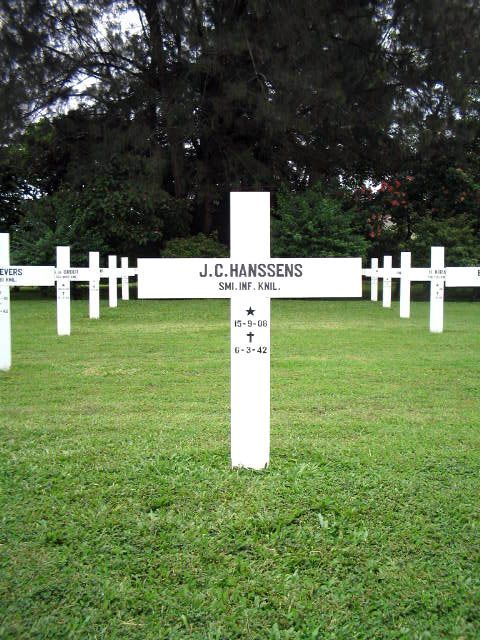
Grave of J. C. Hanssens on the Dutch field of honor Pandu near Bandung. Source: Bert van Willigenburg
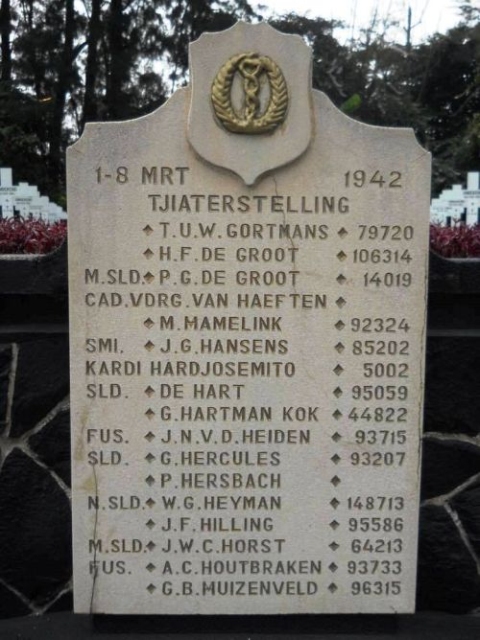
Memory stone on the field of honor Pandu in Bandoeng. The name of J. C. Hanssens has been spelled incorrectly. Source: Bert van Willigenburg
Definitielijst
- brigade
- Consisted mostly of two or more regiments. Could operate independently or as part of a division. Sometimes they were part of a corps instead of a division. In theory a brigade consisted of 5,000 to 7,000 men.
- KNIL
- “Koninklijk Nederlands-Indisch Leger” meaning “Royal Netherlands East Indies Army” (1830-1950). Name of the Dutch army in the Netherlands East Indies.
- machine gun
- Machine gun, an automatic heavy quick firearm.
Surrounded by the enemy
By nightfall the enemy was crawling on our left and right across the road. The machine gun behind us kept firing without a break. Finally, when we were about to overrun, Sergeant Katers shouted: "Retreat". The order was followed right away. We were meant to follow the trench, in order to reach the road, where a vehicle was parked, just a few meters away, to try and find a safe location.
Sadly, It was too late. Patrols had already arrived and searched the vehicle. The whole brigade had gathered itself at the same location, waiting in suspense for what was about to happen. I was assigned to try and get the vehicle up and running. The boys had to run across the road and get into the vehicle, and leave as soon as possible. Passing through the terrain was impossible. We heard Japanese screams from every direction. I returned to inform that too many Japanese were present. When I asked the brigade commander what to do next, the answer was: I will leave this to you. I replied: we are surrounded by the enemy. Though Sergeant Katers knew about this as well.
Of course, we expected orders, but unfortunately he had lost his courage, causing many soldiers to throw away their equipment and some even their rifles, thinking that they had lost either way. The sentiment of panic could be seen in anyone. I repeated again by saying: Sergeant Katers, let us act else, we are lost and will be captured by the enemy. He reacted by standing up and followed what did not take long, in the meantime the Japanese had reached the trenches. We all hid as fast as we can in one of the foxholes, which we had dug up beforehand. A total of sixteen guys found shelter in the holes we dug earlier, later followed by 6 more refugees. Now all we could do was to wait for what was about to come.
This happened around 7:30 in the evening. Most of us kept our rifles. I was also able to obtain a pistol, which had been abandoned or thrown away by someone in the afternoon. We did not know how to act. From all sides, we could hear the enemy approaching. They were already pillaging our encampments, around 10 minutes walking from where we were now. Car and engine sounds came closer and closer. Though the foxholes we were hiding at weren't far away from the bridge, we could hear and imagine everything the Japanese soldiers did. Trees were cut down. Planks in our encampment, that were right there for the taking, need for the extension of our encampment, were now used to repair the bridge as fast as possible. This apparently was successful, since Japanese troops moved on and their cars and trucks passed the bridge, only to halt two or three hundred meters ahead. With more screaming and shouting Japanese soldiers carried out commands. Our whole encampment was soon pillaged and destroyed.
Most of us were waiting impatiently if they would check the trenches. And yes. Late in the evening we suddenly saw two appearances in front of us. Because of moonlight it wasn’t completely dark. No one moved an inch. The two men were carrying flashlights, though only one of them was using it to count with how many we were. The second one took his bayonet from the sheath and attached it to his rifle. What could we do? Fortunately, no one tried to resist. The Japanese, shortly after recognized, said something to each other and continued walking. By miracle they left us there. After this we realized how pinched down we were by leaving without a warning. The enemy either knew or had no idea that we were hiding in the foxholes. Now we realized why there were so many weapons scattered everywhere. For the time being we were underground anyway. Some of us expected never to leave this place alive. Me on the other hand had never thought about surrendering to the Japanese. We agreed not to run away, only if we did it together.
This quickly turned out to go otherwise. Around 12 pm at night Sergeant Katers, our brigade commander, said that he would take a look outside the trench, to see where the Japanese were exactly. He never returned, but laid down somewhere in the terrain without us knowing, that he, due to the many Japanese soldiers, had no chance to return back to our position. However, we thought that he would return at all times, for the sake of his boys. They had the intention to flee. Private first class Wijngaarden also went with Katers. They were both responsible for their men. After we had arrived at Tjisaroea, near Tjimahi, Katers and Wijngaarden arrived a day later to explain the whole situation and stated they couldn’t have done anything else. He apologized and said he should never have done this.
In the morning of the 5th of March 1942, we discovered more of our group disappeared: Rumemper, private K.M. the rifleman, who had dropped his weapon, De Jong, and an unknown soldier, who had joined our group. Six men were no longer with us, who had chosen to flee on their own instead of runaway together. From the beginning more had their doubts. Most of them already lost their courage and were talking about surrendering etc. We agreed further not to talk out loud, nor to smoke and only to keep guard for a possible attack, which we would fight against until the last man standing without surrendering. We had no more commander, only a second class sergeant from the militia. He found himself no longer fit to take charge during a possible attempt to flee. They were the two who claimed during the attack that they were too fat and too tall and thus sat down in the trench while we were doing all the hard work. This happened that afternoon at the bridge, when we first arrived. They proposed that I should take charge, which was a responsible task for me. To take command as a soldier in a situation like this. I proposed to put two men on guard, one on the left, the other on the right. There was nothing left to drink. Only some nasi goreng, which we shared amongst each other. In total we were 16 men strong now.
At one point, early in the morning, a soldier named Vermeesch said, that someone from above ground was calling in Dutch. We listened for some while but never heard something again. Only later we heard it was Sergeant Katers, who at that moment still was hiding in the field, without any chances to escape. He indeed called Vermeesch. We thought at that moment that it was our imagination, so we did not pay too much attention to it. It didn’t take long before we heard voices again asking us to surrender by putting a handkerchief above the trench, else we would die from hunger anyway. I didn’t feel like surrendering and proposed to have patience, to wait and listen what the Japs would do. I figured out they wouldn’t stay here, that we weren't their priority and that they would continue their attack inland. Maybe leaving one guard behind. I recommended to keep watching the left and right side of the shelter, stabbing every shadow we could see with a bayonet, so the Japanese wouldn’t have a chance to do something to us. And this worked. In the afternoon, we saw a shadow approaching, right away we aimed our bayonets and stroke him in the chest. It turned out to be a Japanese soldier, he tumbled and stayed down on the floor. It was our first catch. Some others followed. Through this way we had kept ourselves in the clear, by not thinking we had to fight a superior force. It stayed with a few people in total.
Definitielijst
- bayonet
- Pointed weapon that can be placed at the end of a rifle and used in man-to-man combat.
- brigade
- Consisted mostly of two or more regiments. Could operate independently or as part of a division. Sometimes they were part of a corps instead of a division. In theory a brigade consisted of 5,000 to 7,000 men.
- machine gun
- Machine gun, an automatic heavy quick firearm.
Outbreak
The 6th of March passed, as had the days before. The Japanese had made a habit of leaving in the morning and returning at our encampment in the evening. The third day I had the idea to flee, since all the others wanted to surrender to the enemy, though I didn’t feel like this at all. Our friend, a Javanese, was prepared to go with us. We proposed to scout the trench on the next day, the 7th of March. It would take a long time before daylight arrived and we didn’t see any Japanese in the trench. In the afternoon, around 4pm, we started our journey. The rest would surrender in the evening. The Javanese and I went through the trenches, ready to shoot on sight. The others would wait until we returned, so they could surrender themselves afterwards, if only they weren’t tired and scared, hoping they would be treated well. But we expected to be cut in the ribs, which turned out later to be true, because the Japanese never took prisoners of war during a fight. Around a hundred meters away from our hiding place we stumbled upon a barrier, which had been laid over the trench. Switching turns we stood on each other’s shoulder to see how they changed since we left it. It had been completely overgrown with alang-alang. To the right we could reach the Tangkuban Perahu mountain.
As we had agreed upon, we would leave the trench at half past six to start our journey. The guys were excited for what was about to happen. When we had returned to our shelter, we were overwhelmed by all the questions we received, about what we would do now. I told them we would leave at half past six tonight. In the meantime they had decided that, if we were sure of our cause and convinced them that we would arrive without any problems, with our best help to escape, they would join us as well. I told them, if we stayed in the shelter we wouldn’t be able to walk soon anymore, since the food had run out. Furthermore, I proposed to leave in groups of eight men. The Javanese would take the lead of one group, while I would look after the other. Among us there was also a sergeant Landstorm-soldier, but due to his many complaints I took the lead voluntary, though we were in unknown territory. We couldn’t apply any maps or compasses. We had completely nothing. According to my signal the first group would walk around 100 meters above ground, through the trench, and leave until we had also left the trench.
After much efforts, we managed to reach the terrain. I was the last one who, with the aid of others, got pulled out of the trench. As agreed upon, the Javanese and his group would wait around 50 meters to the right until my group and I had come up. I came up last, passed by my guys and tried to reach the second group led by the Javanese. After an hour of searching I came to the conclusion they had already walked or crouched away instead of waiting for us. In the meantime, it had gotten dark and only the moon gave us light through the forests and mountains. I gave up looking for the second group and returned to my own guys, who had been waiting impatiently laying on their stomachs. We aimed at mountain Tangkuban Perahu and I went first without saying a word to the others. As agreed upon, we couldn’t fire a single shot, in order not to betray our position. We never met our other friends again. We underwent the journey with the eight of us. Left and right in the terrain we heard gunshots and Japanese screams. Around eleven in the evening we encountered a great barricade, which had been placed there by the engineers earlier. We proposed to cut the wires with our pocket knives, after which we went through the barricade one by one. This went quite quickly.
When we reached the mountain at 300 meters distance we heard a group approaching. We thought it were Japanese and I proposed that the guys would wait and see what the sounds could be. With my rifle ready, I walked step by step on some kind of trail on the mountain. After around 100 meters of climbing upward, someone in Dutch asked me: who is there? For one moment I was in shock, but I managed to calm myself down, walked a few more steps and asked the same question. On closer inspection it turned out to be two injured soldiers who were shot down by the enemy and left there because they were no longer able to walk. One of them was an acquaintance, Private First Class Jonker, from the fifth battalion of Semarang. The other was a Major, also from Semarang. Jonker had been at the training, at the Depot-Battalion in Bandoeng, after which he was transferred to Semarang. He recognized me and my voice and asked me if I was Pettinga. When asked him how he got here he told me this.
They were from Semarang, from the fifth battalion, and were assigned to safeguard the defense positions. Since they were attacked by the enemy and trapped in combat, soldiers of their own group came to tell that Japanese soldiers were the best people to be taken captive of, suggesting they should just surrender. At many places they had already handed out cigarettes, and the Dutch prisoners of war were very well received and treated. The others however, kept firing and said: they are our enemies and that’s it. So, while one part continued the fight, which caused many casualties amongst the enemy, the other part surrendered which gave the Japanese the opportunity to surround the fifth battalion of Semarang, and so they lost. Thus 80 men were driven into the open terrain, where everything of value was stolen by Japanese soldiers.
Next, everyone had to remove their Puttees, after which, with their own Puttees, the hands were tied down two on two or three on three, and they were tortured for three or four hours straight. After that, according to the story of Jonker, which we later confirmed ourselves, they aimed a machine gun on them and shot. Everyone who was still alive after was killed in a horrific way. Jonker and his friend survived this and when the enemy had left, they saw their chance to get up from under the bodies and crawled to a safe place, temporarily. They had been laying there for two days since they didn’t have the opportunity yet to run away, while Jonker was shot through both knees and his friend had different belly wounds.
Definitielijst
- Landstorm
- Before 1940 this term designated the various volunteer formations the army in the Netherlands. It was dissolved shortly after the German invasion in May 1940.
- machine gun
- Machine gun, an automatic heavy quick firearm.
Japanese cruelties
I warned the guys who were still waiting on the foot of the mountain. But before I continue a short remark. When an Indo-European is well led, he is capable of doing everything, especially in terms of fighting. If this is not the case, then they see, mainly at night, ghosts and that kind of things which takes away their courage. At this moment, I had 7 Indo-European soldiers with me, amongst them Private Trouvat, Private Ardeseer, Private Smit, Private Wolterbeek, Private Scholtens and two more civilian drivers of whom the names are unknown to me. I told them about my meeting and said we shouldn’t be afraid because those were our friends up there who had been wounded by the enemy, who were afraid to proceed. Also about the many who got killed. When we arrived back at the wounded soldiers, they told us about everything that happened, and how it had gone with the eighty deaths, who were only some meters away from them, who fell into enemy hands. They begged us to carry them away from there.
We promised to save them as soon as we could get our hands on a vehicle. We let them drink the leftover water in our canteens, which made them feel even more thirsty. They asked us to walk a little bit further to convince us that they had told the truth. We didn’t have to walk far until we smelled something unpleasant. The moon was bright, which made it possible for us to see the torn and stabbed boys on the ground. It was indescribable, how and what kind of misery these boys had been going through. Fingers had been cut off to take away the golden rings the soldiers were wearing on them. Bodies were cut open, heads beaten off the torso, yes everything they could see as fun they had done to them.
We checked each and every one, to see if there was one still alive. After some moments I saw someone, I could hardly believe it, whose eyes were open and moved a little. He even seemed able to speak. I gave my rifle to one of my friends, took my pocket knife and freed the wounded soldier, who was totally mutilated. The wounded soldier told us not to let him live any longer, but to kill him with our bayonets, since he was injured to his cervical vertebra and thus never would have been able to stand up again. We took his arms, which had been completely stiffened, carefully from beneath his body and put the soldier with seven other wounded soldiers, who according to us also looked alive. After we put on emergency band aid, and after we told them that we would return as soon as we could, we left. This all happened in the night between the 7th and 8th of march, 1942.
We walked all night. The road had to be taken through the wilderness, to avoid contact with the enemy as much as possible. By day we rested in a kind of canyon. Certainly, we were starving and thirsty. The latter could be solved by drinking from the river. Early morning, the 8th of March, we saw aircrafts fly over. We weren’t sure if we could fight. Our plan was to leave and find a safe place to hide. After a few moments, we discovered a company site and a cabin made of bamboo. First, we planned to stay here overnight, but afterwards, fearing for the enemy, we decided to continue walking. Around 1 PM we discovered trenches and different shelters, probably built by the enterprise staff. We made use of this moment to walk through them. No one was there to be found. Until one moment, we suddenly heard voices appearing from a large road.
Arrived closer, we saw two lorries and a luxurious vehicle, and further down the road another truck and a motorcycle, standing without supervision on the road. In our opinion, we heard people talking in English, while they were wearing Dutch uniforms. They were talking with Indonesian inhabitants. We went to listen if this could be what we thought it was and decided to descend to the enterprise to ask if we could ride along with them. And so we did. One by one we walked down the small hill, but saw the trucks moving again before we could even reach them. The natives did the same, they left as soon as we saw them. In the mean time we could hear engines in the distance, which came closer and closer, but we never paid any attention to this even though we started to have doubts. A few of us pursued the natives, who stopped after they were threatened. The rest of us also stood on the middle of the road. Out of curiosity watching the other cars and motor, with a body laying next to them. We asked the two natives what kind of trucks that were. They replied: English Toean., i.e. English sir. My comrade Ardeseer doubted the truth of these words and said: Ommong-cossong sir. Ini orang Nippon, Prang betoel. Moeso Toean, i.e.: these are Japanese, truly war, enemy sir. With this statement, we let them go and knew the Japanese had also arrived here. The sound became visible, not more than 500 meters away. We fled and ran away in the same way from where we came.
Epilogue
The writer was taken captive on the 8th of March 1942 by the Japanese in Tjisaroea, shortly after the fights mentioned here. Only on the 15th of August 1945 he was liberated from a prisoners of war camp in Burma. In 1949 he ended his military career. Date Pettinga died on the 18th of January 1969 in Assen, at the age of 52.
Information
- Translated by:
- Joshua Rijsdam
- Published on:
- 09-06-2019
- Last edit on:
- 21-11-2023
- Feedback?
- Send it!
Sources
This text was made available to STIWOT by Bert Deelman. The original diary was donated by him to the War and Resistance Centre Groningen in August 2014.
